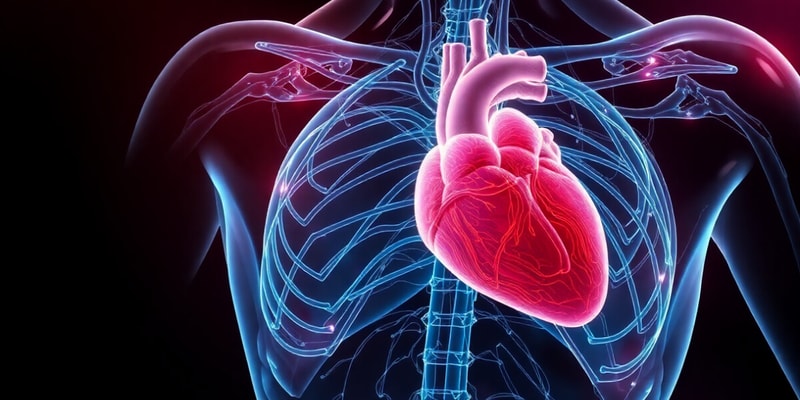Podcast
Questions and Answers
If the sarcomere is too short, the actin filaments do not collide into each other, which reduces tension.
If the sarcomere is too short, the actin filaments do not collide into each other, which reduces tension.
False
Velocity of muscle contraction increases with an increase in load on the muscle.
Velocity of muscle contraction increases with an increase in load on the muscle.
False
Isotonic contraction involves constant tension while the muscle length changes.
Isotonic contraction involves constant tension while the muscle length changes.
True
Cardiac muscle action potentials are shorter than skeletal muscle action potentials.
Cardiac muscle action potentials are shorter than skeletal muscle action potentials.
Signup and view all the answers
The sinoatrial node functions as the heart's pacemaker and is capable of spontaneous depolarization.
The sinoatrial node functions as the heart's pacemaker and is capable of spontaneous depolarization.
Signup and view all the answers
Isometric contraction allows the muscle to change in length while generating force.
Isometric contraction allows the muscle to change in length while generating force.
Signup and view all the answers
In cardiac muscle, the action potential spreads through coupled cells due to gap junctions.
In cardiac muscle, the action potential spreads through coupled cells due to gap junctions.
Signup and view all the answers
Smooth muscle is characterized by striations similar to skeletal muscle.
Smooth muscle is characterized by striations similar to skeletal muscle.
Signup and view all the answers
Cardiac muscle can go into a state of tetany due to its action potential duration.
Cardiac muscle can go into a state of tetany due to its action potential duration.
Signup and view all the answers
The entire cardiac muscle behaves as a single cell due to the presence of electrical syncytium.
The entire cardiac muscle behaves as a single cell due to the presence of electrical syncytium.
Signup and view all the answers
A sustained muscle contraction due to high levels of stimulation is known as tetanus.
A sustained muscle contraction due to high levels of stimulation is known as tetanus.
Signup and view all the answers
Recruitment of motor units begins with the largest motor units being activated first to control muscle contraction.
Recruitment of motor units begins with the largest motor units being activated first to control muscle contraction.
Signup and view all the answers
The relationship between muscle fiber length and force generation is represented by the Length-Tension Curve.
The relationship between muscle fiber length and force generation is represented by the Length-Tension Curve.
Signup and view all the answers
In cardiac muscle, the mechanism of contraction is similar to that of skeletal muscle, involving direct nervous stimulation.
In cardiac muscle, the mechanism of contraction is similar to that of skeletal muscle, involving direct nervous stimulation.
Signup and view all the answers
Temporal summation refers to the increase in muscle contraction strength through varying the frequency of action potentials.
Temporal summation refers to the increase in muscle contraction strength through varying the frequency of action potentials.
Signup and view all the answers
Skeletal muscle contraction can only be varied by changing the frequency of nerve impulses.
Skeletal muscle contraction can only be varied by changing the frequency of nerve impulses.
Signup and view all the answers
During prolonged muscle contraction, motor units take turns activating to minimize fatigue.
During prolonged muscle contraction, motor units take turns activating to minimize fatigue.
Signup and view all the answers
As a muscle is overly stretched, the number of interactions between actin and myosin increase.
As a muscle is overly stretched, the number of interactions between actin and myosin increase.
Signup and view all the answers
Cardiac muscle is characterized by having more precise control compared to skeletal muscle.
Cardiac muscle is characterized by having more precise control compared to skeletal muscle.
Signup and view all the answers
A simple muscle twitch involves a contraction that is immediately followed by relaxation.
A simple muscle twitch involves a contraction that is immediately followed by relaxation.
Signup and view all the answers
Study Notes
Skeletal Muscle Contraction
- Motor Unit: A motor neuron and all the muscle fibers it innervates
- Recruitment: During a contraction, smaller motor units are recruited first, and as more force is needed, larger motor units are recruited. This allows for a graded increase in force.
- Tetanus: A sustained muscle contraction caused by a high frequency of action potentials, resulting in a sustained rise in intracellular calcium.
- Length-Tension Curve: The relationship between resting length of a muscle and the force it generates. An optimal resting length exists for maximum force generation.
-
Types of Muscle Contraction:
- Isotonic: Constant tension, muscle length changes (e.g., lifting an object)
- Isometric: Constant length, tension doesn't exceed the load (e.g., holding an object steady)
Cardiac Muscle
- Spontaneous Depolarization: Cardiac muscle has its own "built-in" pacemaker (sinoatrial node) capable of spontaneous depolarization, generating action potentials.
- Long Action Potential: Cardiac action potentials are significantly longer than skeletal muscle action potentials. This prevents tetany which would disrupt the heart's pumping function.
- Electrical Syncytium: Gap junctions connect cardiac muscle cells, allowing action potentials to spread rapidly, creating a functional syncytium where cells behave as one unit.
Smooth Muscle
- Smooth Muscle Contraction: Calcium binds to calmodulin, activating myosin light chain kinase. This phosphorylates myosin, allowing it to bind to actin and initiate contraction.
Key Differences between Muscle Types
- Skeletal Muscle: Striated, voluntary control, rapid contraction, short action potential
- Cardiac Muscle: Striated, involuntary control, rhythmic contractions, long action potential
- Smooth Muscle: Non-striated, involuntary control, slow sustained contractions, contractions triggered by various factors (neurotransmitters, hormones, stretch).
Studying That Suits You
Use AI to generate personalized quizzes and flashcards to suit your learning preferences.
Related Documents
Description
This quiz explores the mechanisms and types of muscle contraction, focusing on skeletal and cardiac muscle. Key concepts include motor units, recruitment, tetanus, and the length-tension relationship. Test your understanding of muscle physiology and its unique features.




